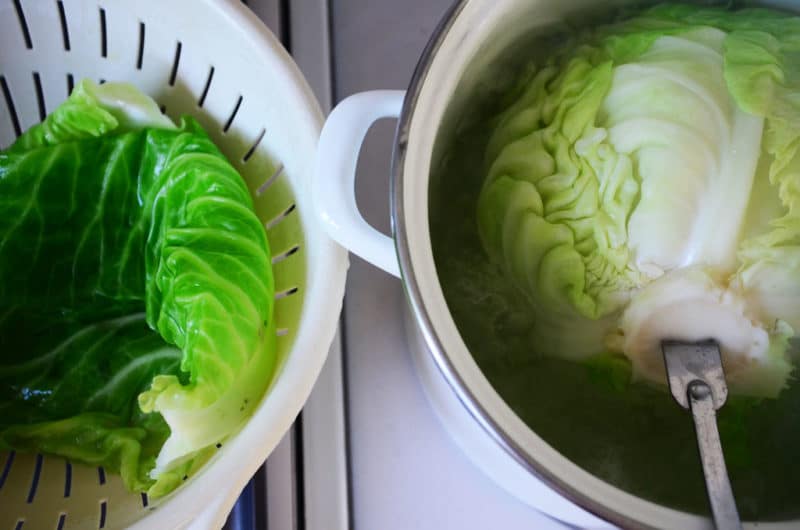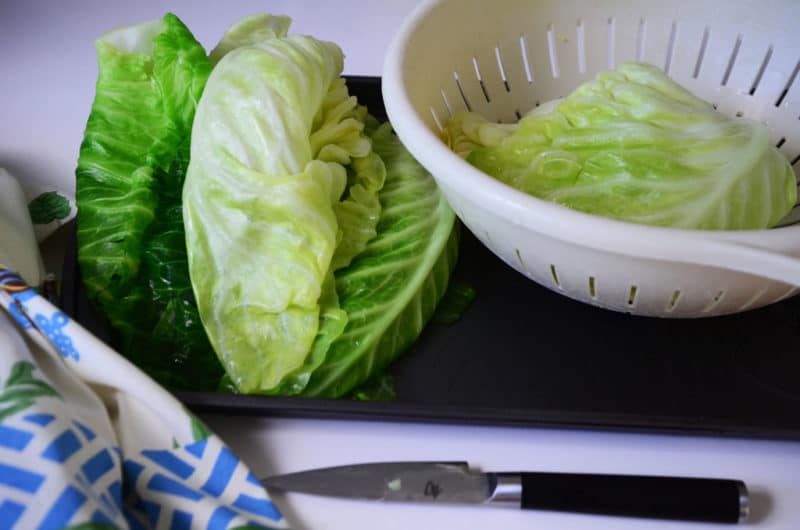How to blanch cabbage for rolls
Jul 25, 2012, Updated Jan 02, 2015
This post may contain affiliate links. Please read our disclosure policy.

Cabbages, like onions, are made of tightly wound layers. Leaves of cabbage want and need to be softened so that they are pliable enough to be pulled off of the head and rolled up with stuffing.

Here’s the simple blanching process:
Pierce the core of your fresh cabbage, tough outer leaves removed, with a two-pronged fork. Think fondue.
Get a big pot. Fill the pot up half way with water. Bring the water to a boil. Salt the water.
Place a colander over a sheet pan next to the stove.
Place the head of cabbage in the water with the fork and turn it all around to blanch the outer leaves. As the cabbage softens (a minute or two), lift the head from the water. Let the water run out of it. Use a paring knife to cut away the outer leaves over the colander, leaving them in the colander to drain.
Place the cabbage back into the boiling water and repeat, cutting off all of the layers of leaves until you’ve reached the core of the cabbage where the leaves are too small and curly to use.
There will be about 20 leaves, some of them technicolor green, others yellow. All good.
Additional note: During this process, don’t drop your beautiful but demonic camera on the kitchen floor, watching it slam against the dishwasher as it goes down, or else the camera will go dark and you’ll have to stop making cabbage rolls and slam your own head against the dishwasher in disbelief, then drive all the way to Traverse City the next morning to either get it fixed (if you’re lucky) or buy a new one (if you’re not).












I cut the core completely out of the cabbage and put core down in a bowl filled with two inches of water. Put in microwave for three minutes, take out, remove outer leaves by rolling up each leaf to core end and repeat. Takes all of ten minutes to get every leaf off. No splits and so easy.
Fabulous Diane, thank you!
I know I am a little late to the party here, but my mother also cuts out the core first, then just retrieves the leaves as they fall away. My (paternal) grandfather, however, he buys cabbage on sale and puts it in the freezer. He doesn’t blanch it afterwards. The freezing and thawing process softens the leaves enough to roll.
I love this idea and I can’t wait to try it! Thank you Kaylynn!
Thank you ! I have always made “pigs” for New Year’s I started long before Google was invented lol I will be making 50 today ! Using this method for the cabbage thanks
Wow, 50!!! Enjoy!!
good comentary i enjoyed it and your tips are great
Maureen, I love all your recipes. I have a trick passed down that is even easier to soften and separate your cabbage. Simply put it in the freezer the day before then thaw under running water and they will peel apart like a breeze. Try it and let me know what you think.
Someone else also mentioned this and now I’m so curious! Thank you–can’t wait to try it!
Well described and explained, as always Maureen. What do you think about the technique that calls for freezing the cabbage, then blanching it? The freezing breaks down the hard ribs and makes the leaves easier to roll. I’ve not made them this way, but if I see the technique mentioned in two or more recipes, I pay attention……but I’ll defer to your opinion!
That is something new to me, freezing the cabbage. I’m going to give it try though, thank you! Since the cabbage is cooked so thoroughly I’m sure the freezing isn’t such a big problem for cabbage texture, though that’s what I’d be on the lookout for, compromised cabbage texture by freezing.
I tried. The cabbage fell off the fork, boiling water burned my face, yet I persevered. Leaf by leaf, burning my fingers, steaming my face. This method may work well for the curly-leafed cabbage you are using, but definitely not for the smooth cabbages with tightly bound leaves. The cabbage has to be much more than just blanched to get the leaves off without ripping. It has taken me a couple of hours to get all the leaves off.
Hello! And sorry for your cabbage blanching trouble–I love your determination! I find with any cabbage that after the first couple of layers, the leaves blanch and pull off relatively easily. You can also use tongs to assist, but there are times when the hot water splashes and that’s no fun!
Wow…I tried this tonight…Thank you!! It made making the cabbage rolls so much easier!!!
Fantastic Tanya!
Absolutely funny notes!!! had been some time since I had made cabbage rolls so searched for coring cabbage and came upon your site. Simply made my day . daughter and I got the giggles for some time after. very funny. thanks for all the tips.
Your technique worked beautifully; nary a torn leaf, all the way to the tiny ones.
I started removing the leaves with my hand until my thumb got too hot. Then I smartened up and grabbed a pair of tongs to lift off the remaining leaves.
I thank you, and my Sarmale thanks you.
Very effective technique!
Maureen, laughing just as much as I did a year ago–now I have to make some coosa–
I, too,enjoyed the camera story, maybe a tripod? I learned to make cabage rolls from my my Granny. There were five of us cousins that lived on their property. She loved to tell the story of the day she was having a Home Demonstration party and the five cousins ate all of the cabbage that she had made for her party!
I will try the fork and knife and maybe not burn my fingers. Thanks
Maureen, laughing out loud–what is it about cabbage rolls that is so amusing–but then again, I guess it is about you and your camera–love your column and all the comments–and I LOVE cabbage rolls, and with or without luban–I agree with Gerald, I like them even more than grape leaves. And Janet, my mother used that technique also. Would be fun if we could all meet over a pot of stuffed cabbage. Never stop writing Maureen–you bring smiles to my heart.
Interesting, cabbage rolls are my favorite.
Grape leaf rolls are good too but I don’t usually eat them as heavily as the cabbage rolls.
When mom used to make them, a large kettle full, we kids would keep asking if they were done yet, the smell made us very hungry. She would eventually serve it asking if the rice was done, we always said yes but frankly I got used to eating somewhat crunchy rice…..didn’t care, a great dish (tomato based in our case).
And with cabbage rolls I often to this day eat only the rolls as the main dish. It is not unusual for me to eat three or even more. Never knew for sure if the leafs were blanched or not, I should have guessed but never noticed how they were prepared.
I saved my camera and accessory equipment once, when returning home from an outing I had my arms full of various camera items, I tried to jump over the trailer hitch at the back of the car, caught my foot, started to fall but refused to let go of the camera. I went down on concrete with both elbows, camera was safe, I was wiser and of course much younger. I wouldn’t survive a fall like that today. Good luck with the repairs.
Okay that makes much more sense than how Aunt Gladys taught me. She had me blanch each leaf individually–which I dutifully did–but your method sounds like it would work out better. I can’t wait to read your next installment!
Boy, does that look good. What??? You dropped your camera AGAIN?? I am going to get you a strap for around your neck!! One quick tip I learned from my mom. Cut the core out of the cabbage and when the leaves soften, your able to use your tongs and pull them out one at a time because the fall away from the head as they soften.
What time is dinner??
i hope you didn’t drop your camera !